Saint Bernard Dog Breed Information: Facts, Pictures & More
When you purchase through links on our site, we may earn a commission. Here’s how it works.
Long ago, amid the snowy peaks of the Alps, was a hospice where pilgrims journeying to Rome could find rest before continuing their dangerous trek. Many of these travelers were unlucky enough to become injured or lost in the snow. These people were rescued by large, friendly dogs we now know as Saint Bernards. These giant dogs were bred to survive the harsh weather conditions of the Swiss Alps.
These days, Saint Bernards are well-known for their depiction of dogs saving people trapped in the snow, often carrying a cask filled with alcohol around their necks. Many will also recognize them from the classic family movie Beethoven.
While they prove to be intimidating to some due to their size, Saint Bernards are nothing but big balls of cuddliness. Easily trained and greatly attached to their owners, they serve well as companions for people who need a nurturing presence in their lives. Dependable, sociable, and playful, this is a breed that any large dog enthusiast should consider as an option when adopting a dog. Let’s jump in and learn everything you need to know about these gentle giants before welcoming one into your home.
Table of Contents
Breed History

The earliest known record of the breed is from around 1660 to 1670 when native dogs from the surrounding farms of the Alps were crossbred with Mastiff-type dogs brought by Roman soldiers from Asia. The Saint Bernard and the English Mastiff are often compared to each other, with few differences due to their origins.
The birthplace of the breed can be traced back to our previously mentioned hospice, The Great Saint Bernard Hospice. This hospice was founded by a monk, Bernard of Menthon. The hospice lies in a dangerous snowy pass that was named after Saint Bernard in the Western Alps, about 8,100 feet above sea level.
Concerned with the safety of the travelers crossing the mountain pass, whom most are pilgrims en route to Rome, he founded the hospice in the year 1050 to help them in their travels. It was a place of refuge when the weather was rough and unforgiving.
Despite popular belief, the breed didn’t always have their long coats. The dogs used for snow rescue were originally short-haired. It sounded reasonable that a thick-furred dog will survive the climate of the Alps better. As such, some dogs were crossbred to have longer fur. However, it turned out that the snow weighed their coats down significantly. These dogs were unsuitable for rescue work due to their fur freezing in the cold. The long-haired breeds were given out to patrons in the neighboring villages; they then spread out from there.
Being Used in Rescue
Saint Bernards were mainly used as guides for travelers in the Alps. They carved a path by braving the thick snow and plowing through it with their powerful bodies. They used their great sense of direction to navigate the Alps even in a blinding snowstorm. The breed also served as the protectors of the hospice, guarding the establishment against wild animals and burglars; one account of such an event was recorded in 1787.
At some point, the monks discovered that the breed had an exceptionally good sense of smell and could find lost travelers buried in the snow. The breed was celebrated and beloved throughout the hospice. However, not all things were good for the dogs. Many of the dogs in the hospice died while doing rescue work, which almost led to the extinction of the hospice’s Saint Bernard lineage. The monks were able to save them by cross-breeding them with the other dogs in the neighboring villages, replenishing their population back to a healthy amount.
On record, Saint Bernards have saved more than 2,000 people over their 300 years of service to the hospice. The most famous of them, saving a total of 40 travelers who almost died in inclement weather, was Barry. Barry is considered to be a national hero in Switzerland for his service in the mountains. He died of old age after 12 long years of service, and his body can be seen proudly displayed in the Bern National History Museum.
Today, Saint Bernards have been replaced with helicopters in rescue missions around the Alps. These carry lighter and more nimble dogs, such as German Shepherds; this allows for more efficient navigation and rescue. Despite this, the Great Saint Bernard Hospice still holds their dogs in high regard. Both the hospice and the breed serve as reminders of the kind-heartedness and care of humans and animals alike.
Breed Recognition
On March 15, 1884, the Swiss Saint Bernard Club was founded in Basel. In the same year, the Swiss Dog Stud Book was authored, with a Saint Bernard named Leon as the first dog registered in the book. A year later, an International Dog Show was held in the same place. As many of the contestants were Saint Bernards, this greatly contributed to their worldwide fame.
The breed was officially recognized as a Swiss breed at the International Canine Congress on June 12, 1887; the breed standard was declared as binding. Since then, the breed has cemented their title as Switzerland’s national dog, and rightfully so.
In Popular Culture
As previously mentioned, Saint Bernards are known to have carried casks of alcohol around their necks in their rescue operations. However, this was declared false by the monks at the hospice. The myth can be traced back to Edwin Landseer’s painting, titled Alpine Mastiffs Reanimating a Distressed Traveler, where one of the dogs sports a small barrel on their neck. The trope persisted into popular modern media, which is how many of us know the breed. They achieved even more fame after the now-beloved family movie Beethoven premiered in 1992.
Today, many families all over the world are proud to share their homes with these gentle giants. While they don’t do much in the way of rescue work anymore, they are perfectly suited to be loving, gentle family companions. The AKC ranks them at #48 of 193 on their breed popularity list.
Temperament
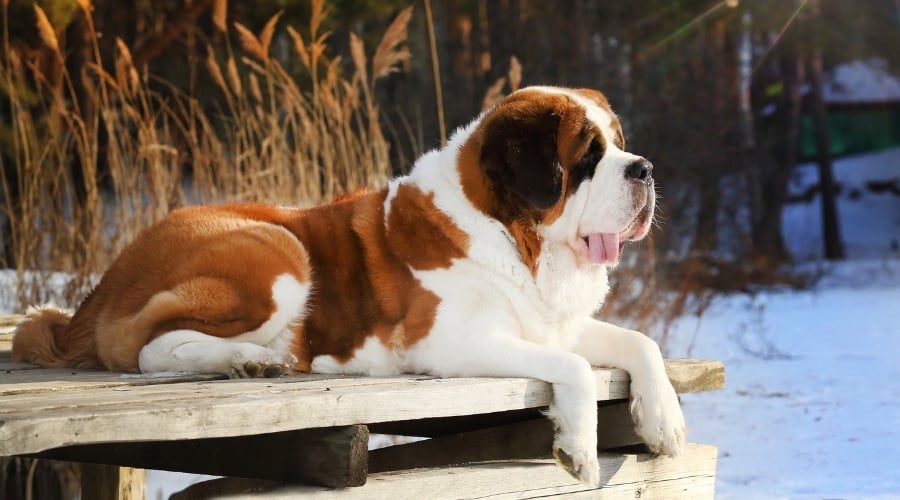
Many may be intimidated by their size, but don’t let this fool you. Saint Bernards are actually very friendly, gentle giants who love the company of their families. They are calm, sweet, and very patient with adults and kids alike. Their famous love of children has given them fame as nanny dogs. They also get along well with other pets, especially when raised alongside them.
As usual, proper socialization is important to harmonious home life, but you’ll find your Saint Bernard will love every member of your family regardless. Bear in mind that they typically want to be with their owners, so keeping them outside or leaving them alone for extended periods can trigger some pretty terrible separation anxiety.
This breed is very even-tempered and will rarely bite or bark without reason. Early training will be enough to curb barking from their natural protective instincts. As previously said, this breed’s love of children makes them a great family pet. However, take care to supervise their interactions. When not properly trained, these dogs may excitedly jump onto someone and topple them over in the process– particularly hazardous for smaller children.
Saint Bernards are well-suited for pet owners who cannot devote much time to their dog’s exercise. This means that even active seniors and disabled people can enjoy life with this breed. These dogs don’t require a lot of time outdoors at all and are often happiest when they can laze about with their loved ones. That doesn’t mean that they’re not good for working dog roles, though.
True enough, Saint Bernards love being showered with attention; this makes them both easy to please and eager to please. Training comes fairly easily to this dog, provided there is plenty of positive reinforcement. When trained from an early age, they are obedient and have a great future as service dogs, just like their ancestors from the hospice. Their strong bodies make them a good choice not just for rescue missions, but for sporting events, too. They are a perfect choice for a therapy dog, given their propensity for nurturing.
Size & Appearance
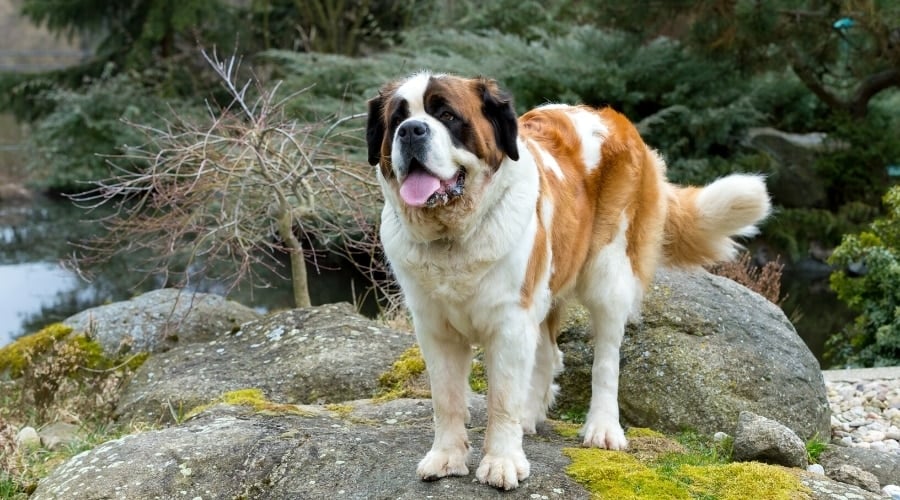
It’s no secret that this breed is huge. Their frames are large, powerful, and imposing. Males stand at a minimum of 27.5 inches at the shoulder; females stand at 25.5 inches. They are incredibly heavy, with males weighing an average of 160 pounds, and females weighing 130 pounds.
Some Saint Bernards grow to be much larger than that; Benedictine V Schwarzwald Hof weighed by the Guinness Book of World Records to be an astounding 315 pounds.
Saint Bernards have huge heads featuring wrinkled brows. This is paired with a short muzzle and dark, inquisitive eyes. Their ears hang gently and end slightly above their jowls. They are floppy and form a rounded triangle shape. The AKC requires that the lips and nose always be black. Speaking of lips, you’ll notice very quickly that they have a strong tendency to drool, so watch out when giving them cuddles.
Saint Bernards are especially sturdy, though that doesn’t come as a surprise to anyone. Their chests are moderately deep, not reaching below the elbows, and their backs are broad and straight. Their legs are massive and muscular, and their paws are broad and strong. All these allow for the dignified stance the breed is known for.
Coat & Colors
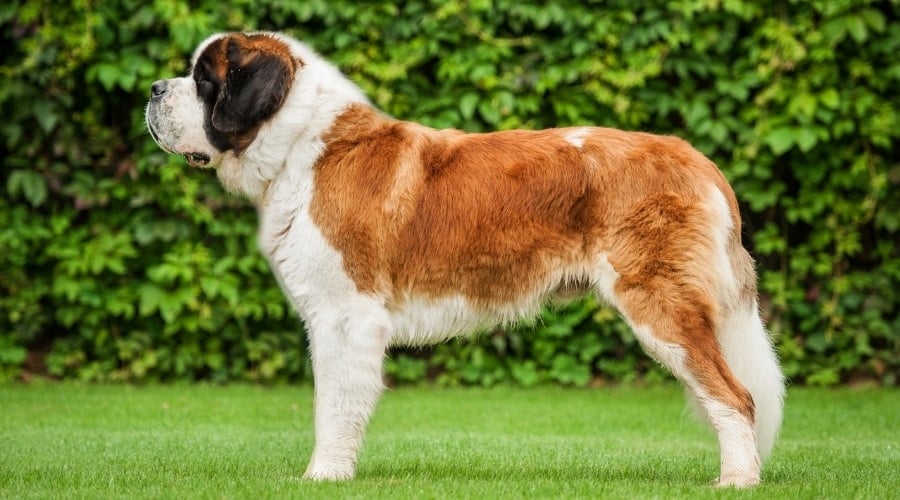
Saint Bernards have very dense, tough coats to help protect them from the cold. As we mentioned earlier, the breed comes in both short-haired and long-haired varieties. The difference between the two types of coats, beyond length, is texture.
Short-haired Saints have straighter, smoother fur, with slightly bushy hair on the thighs. The tail is covered in fur that is considerably longer than that found on the body. Long-haired Saints have a rougher, wavier fur texture, but it is never curly or shaggy. Both the thighs and tail are bushy.
You’ll find Saint Bernards to be either white-with-red or red-with-white; they are never just one color or without white on their bodies. The shade of “red” also varies. Their markings can be red, but they can also be brown, rust, orange, or even brindle. The AKC accepts all varieties of red and brown-yellow, though other colors are deemed faulty.
About markings, the breed is usually seen with a black “mask” covering their eyes, though it is parted in the middle. This patterning was bred into them to help with the glare of the sun reflected off the snow. This also often extends to their ears, rendering them a darker color. Other special markings required by the AKC are “white chest, feet, and the tip of tail, noseband, collar or spot on the nape” A white blaze is also preferred.
Exercise Requirments
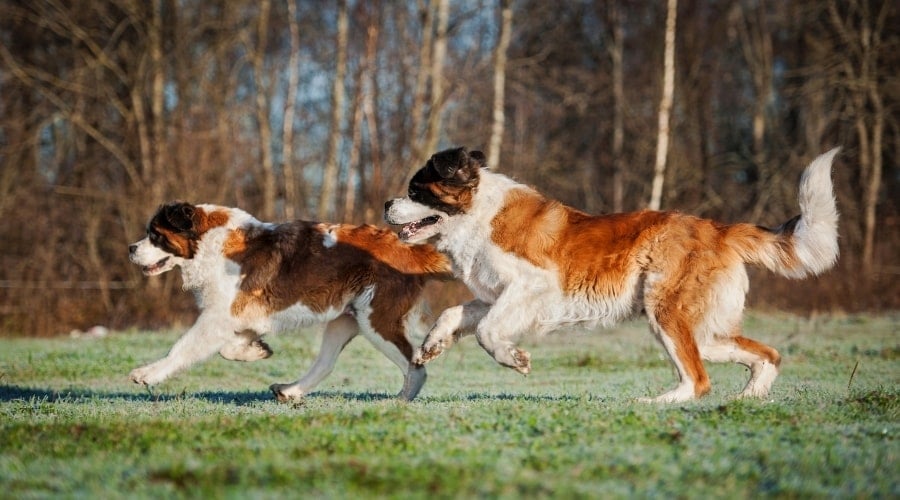
These gentle giants can be lazier than most dogs but still need exercise to stay healthy. They do not require much of it and will very rarely demand it from their owners. For this reason, you will need to set aside time each day to incorporate it into their daily routine.
They will be content with a 20-minute walk to get their muscles working, though they can go on longer walks too, depending on the weather. You may be surprised at how much they love playing in the wintertime. Saints are known to enjoy cart-pulling, especially when they see how happy they can make their playmates– your kids.
Living Conditions

Saint Bernards aren’t especially suited for smaller living spaces due to their sheer size. They don’t need a palatial home but will probably not be happy in an apartment setting. Living in a smaller home may prove to be a challenge, as the breed is well known for knocking things over. As such, ensure their living spaces are roomy.
They will also need sufficient time outdoors to stretch their legs. Since they do not need a lot of exercise, you don’t need to bring them outside too often for this purpose. Instead, you will find your Saint Bernard to greatly benefit from a fenced-in yard that they can roam around and play in; these are also great for afternoon naps.
The breed originated in the Alps, thus, these dogs have a very dense coats. They prefer colder climates and will be happy when the snow comes. Conversely, they are poor at tolerating heat and can really suffer in hotter weather. In the summertime, be sure to keep them indoors as much as possible. They will need a steady supply of water at all times to prevent them from overheating.
Training

You will need to train your Saint Bernard as soon as possible. This isn’t because they are particularly stubborn but because they grow so large. Pups who aren’t properly trained will definitely be toppling people over from excitement and can very easily cause injury. This means training needs to start at a young age.
Patience, gentleness, and consistency are the key to a well-behaved dog. Your instruction should be firm but never mean. Saints are definitely a sensitive breed and rely on you to treat them properly. Positive reinforcement is necessary; give them lots of praise, pets, and treats. This will make training easier for both you and your dog. Saint Bernards should be trained with basic obedience commands first.
Leash training is also imperative; you don’t want to end up as the one being walked when you two are out and about. After basic training is complete, you can then move on to more complicated work, especially if your pup will be working as a service dog.
Socialization is important in helping your Saint Bernard realize their own strength. Thankfully, this is easily done. The breed is by nature friendly and sociable. They will quickly warm up to new faces.
However, they can also be protective in situations where their family is uneasy, though it usually takes a lot for them to feel threatened. Socialization is a great way to ensure that your dog doesn’t grow up shy or anxious. Enrolling your Saint in a puppy kindergarten class is recommended to help them learn appropriate behavior among other dogs.
Health
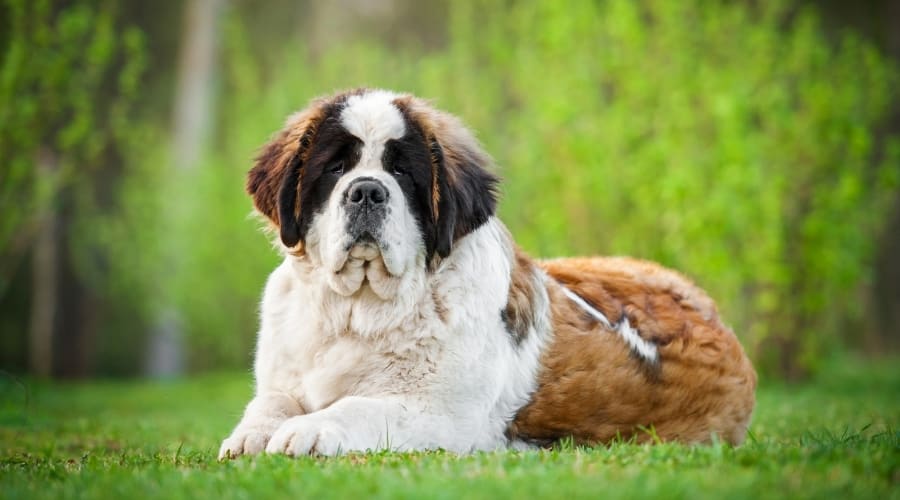
Saint Bernards are large, powerfully built dogs with much vigor in their bodies. When purchased from a reputable breeder, you can expect your dog to be pretty healthy. However, as this is a giant breed, they tend to live shorter lives than smaller breeds do. These dogs only tend to live around 8 to 10 years. As such, it’s important to invest in their health so those years are the best they can be. Many healthy Saints can live longer than their life expectancy.
Like all dogs, Saint Bernards have certain genetic conditions they are predisposed to, often due to their size. Not every dog is going to have these conditions, but it’s still worth reading about them. Understanding these ailments can help you figure out a treatment plan with your veterinarian much sooner.
Hip Dysplasia
Being a giant dog means that the breed is prone to hip dysplasia. This is a condition where the dog’s thigh bone does not fit properly into the hip socket. This is very painful and can result in irregular posture, a strange gait, and a limp in one or both hind legs.
Because they are so large, carrying all their weight while having hip dysplasia can truly reduce their quality of life. As the condition is often hereditary, good breeders will screen for hip dysplasia. Be sure to ask your breeder about hip dysplasia and any other conditions your Saint may be predisposed to.
Gastric Torsion
Larger dogs with deeper chests are prone to gastric torsion. Gastric torsion, or bloat, is a condition where the stomach is distended, often filled with air or gas, and then twists. This can be life-threatening as the dog’s blood pressure drops, and they go into shock.
Outward signs are retching without vomiting, a distended belly, increased heart rate, and restlessness. Another sign is excessive drooling, so if your already drooling dog is salivating more than usual, something may be wrong.
Bloat is caused by consuming too much food or water at a fast pace. Therefore, it is easily avoided as long as your dog is eating and drinking the right amount– and not too quickly. This can also occur if your dog exercises too soon after eating. To be safe, allow your dog to exercise only if at least an hour has passed since their last meal.
Eye Conditions
Saint Bernards can also develop eye conditions. Cherry eye is one such condition, referring to the swelling of the third eyelid after a tear duct has prolapsed. It will look like a cherry forming at the inner corner of their eye. This is corrected with surgery.
Other eye conditions the breed is predisposed to include entropion and ectropion. Entropion occurs when the eyelids roll inward, thus rubbing at the eye’s cornea. Ectropion is the opposite condition, where the eyelids droop and expose the cornea. Entropion can be very painful, while ectropion is sometimes normal. Regardless, if your dog develops any of these conditions, it’s best to consult with a veterinarian to see options for treatment.
Nutrition

The building blocks of your Saint Bernard’s good health are complete, balanced nutrition. This means giving them a diet with everything they need to grow up healthy and stay healthy.
Because this is a giant breed, they will need food appropriate for their breed size to ensure that they get all the nutrients necessary for their wellness. You can achieve this with a high-quality, dry kibble appropriate for your Saint Bernard’s life stage. This allows them to develop properly in their puppyhood and maintain good health in their adult and senior years.
As puppies, Saint Bernards have a lot of growing up to do. For many dogs, growth does not stop until they reach two years of age. It can be dangerous for your Saint puppy to grow up too fast, so ensure that you’re giving them the right amount of puppy food for their size. Adult and senior dogs will need to eat more food but less frequently.
The amount to feed your pup will depend on their age, size, and activity level. As a rule of thumb, older dogs will need less food than younger dogs who are more active. Understanding how much food to provide your dog may be difficult, so it’s always best to consult your veterinarian, especially as your dog is growing.
Feeding them too much can lead to obesity, which opens the door to many preventable diseases. This breed, in particular, has a difficult time with obesity because it adds extra weight to their already heavy frame and may cause mobility issues.
Grooming
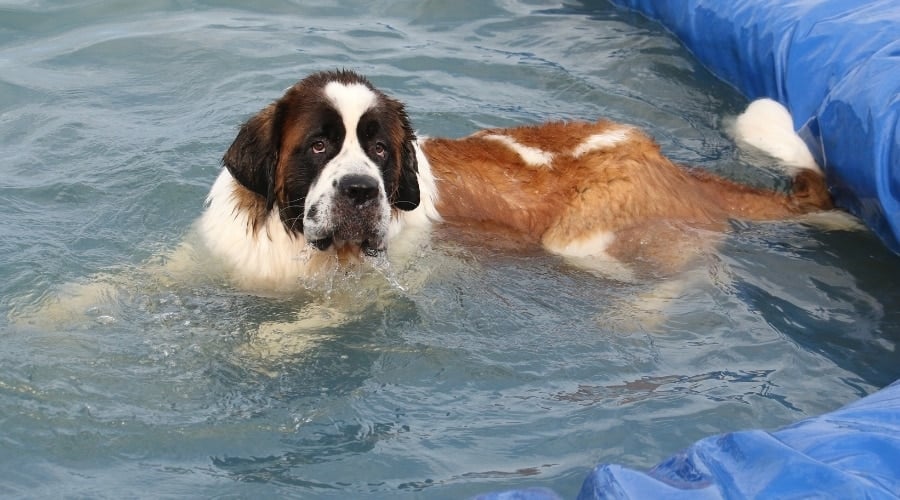
Regardless of coat length, this breed requires frequent grooming. For one thing, they shed a lot– which may be an understatement. They typically shed heavily twice a year, in the spring and fall. They also shed outside of those periods, so be ready with your lint rollers and vacuum cleaners.
You can make the shedding process much easier by brushing your Saint Bernard as much as possible and using a deshedding tool. Daily is preferable, though you will definitely need to increase frequency during shedding season. If shedding is a problem for you, there are Saint Bernard hybrid dogs that shed less, such as the Saint Berdoodle.
Saint Bernards don’t really need haircuts, as their fur does not grow past a certain length. However, you can trim the fur on their feet to help keep movement easy for them. Bathing your Saint Bernard is also important, though they do not need baths too often. Simply bathe them when they get visibly soiled or once every eight weeks. It is best to do their brushing before bathing to prevent mats and tangles.
You should also keep your Saint Bernard’s ears clean. Wipe around their ear canal with cotton and an ear-cleaning solution, which you can purchase from your vet. This removes excess wax, plus dirt and debris. Brushing their teeth regularly is also important, as this helps prevent disease.
Breeders & Puppy Costs
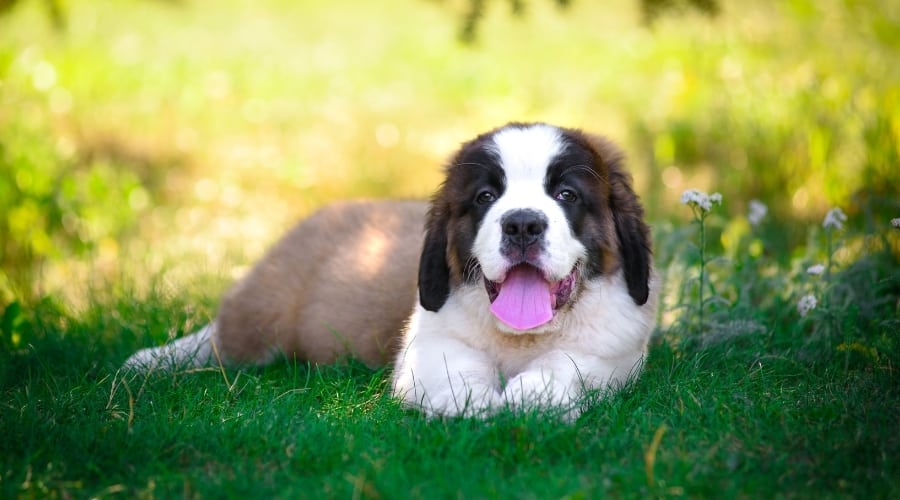
Choosing to purchase a purebred puppy from a breeder is a good option, though you need to be sure the breeder is both reputable and responsible. Many unscrupulous breeders run puppy mills where the only purpose of the business is to generate profit. In these places, the dogs are treated inhumanely. They’re often abused; their living conditions are unsafe, and there is a lack of clean food and water. When looking for a breeder, ask to see where the dogs are kept. Good breeders will have clean and comfortable conditions for their dogs.
Beyond this, a responsible breeder will be enthusiastic about the Saint Bernard breed. They will be able to tell you everything you need to know about adopting your new dog, as well as answer any questions you may have. These breeders will have a real love and respect for their Saints and will require you to have the same. They will also be able to provide you with veterinary certification on any tests, deworming, and vaccinations your puppy has had.
Looking for a good breeder can be a difficult task. It’s a good idea to check your local veterinary clinic for leads early on in your search. Looking up breeders online in dog communities can also yield great results.
Offline, you can opt to go to dog shows and ask the local enthusiasts, as they probably will be able to give you good answers. Lastly, the AKC has a fantastic resource for breeder referrals. Expect to pay around $1,500 for a pet-quality purebred puppy. Show-quality dogs range anywhere from $2,500 to $10,000.
Rescues & Shelters

While reputable breeders are always a good place to check for a potential new furry friend, we always recommend that you check your local rescues and shelters first. These are great places to find a loving family companion. It’s definitely possible to find a purebred Saint Bernard among the dogs at the shelter.
Adopting from a shelter makes a huge difference to the dog you are rescuing. For one, they’re all very sad to be there. Beyond that, many dogs at rescues are seniors or dogs with special needs— they will need someone to help them have those needs met. Above all, you are really saving a life. The American Society for the Prevention of Cruelty to Animals states that of the 3.3 million dogs entering US shelters each year, 670,000 are euthanized.
Be sure to ask your shelter about your dog’s background. Learning their history will do both of you a lot of favors in understanding their health and temperament– something essential to their quality of life.
While you are vastly improving the life of the dog you are adopting, remember to be patient with them. Many are shy and anxious and will require time and care to get them out of their shells. Enough love and care will help your new friend trust you as soon as possible, and they’ll be back to the happy, gentle giants they were always meant to be.
As Family Pets
- Saint Bernards are gentle and nurturing.
- These gentle giants do not need a lot of exercise.
- They are incredibly affectionate.
- They may experience separation anxiety due to their velcro nature.
- Saint Bernards love children and other pets.
- They will be happiest in a home with space, and a larger yard.
- This breed sheds a lot, which will be a problem for allergy sufferers.
- They will need regular grooming to manage their shedding.
- They fare best in colder climates, and will quickly overheat in hot weather.
- Because they are a larger breed, they will need training to prevent them from knocking people over.
- Younger dogs are best suited in homes without very small children or elderly individuals.
- Due to their energy levels when young, they may knock people over, causing injury.
Final Thoughts
We hope this article has shed (pun intended) some light on the wonderful, loyal, slobbery Saint Bernard. Welcoming this dog into your life is sure to bring a lot of happiness to your family. You must return that happiness by understanding how best to take care of your new dog. They’re counting on you to love them well since they’re more than capable of returning that love.
Taking care of a Saint Bernard can be a lot of work, but those happy, droopy faces are always worth it. Their big bodies hold so much love and affection… and drool, so you had better prepare yourself. Giving them the life they deserve by understanding and meeting all their needs is sure to strengthen your bond. They’ll be happy to be by your side, whether adventuring through the snow or snuggling by the fireplace… though ask any Saint, they’d prefer the latter.



